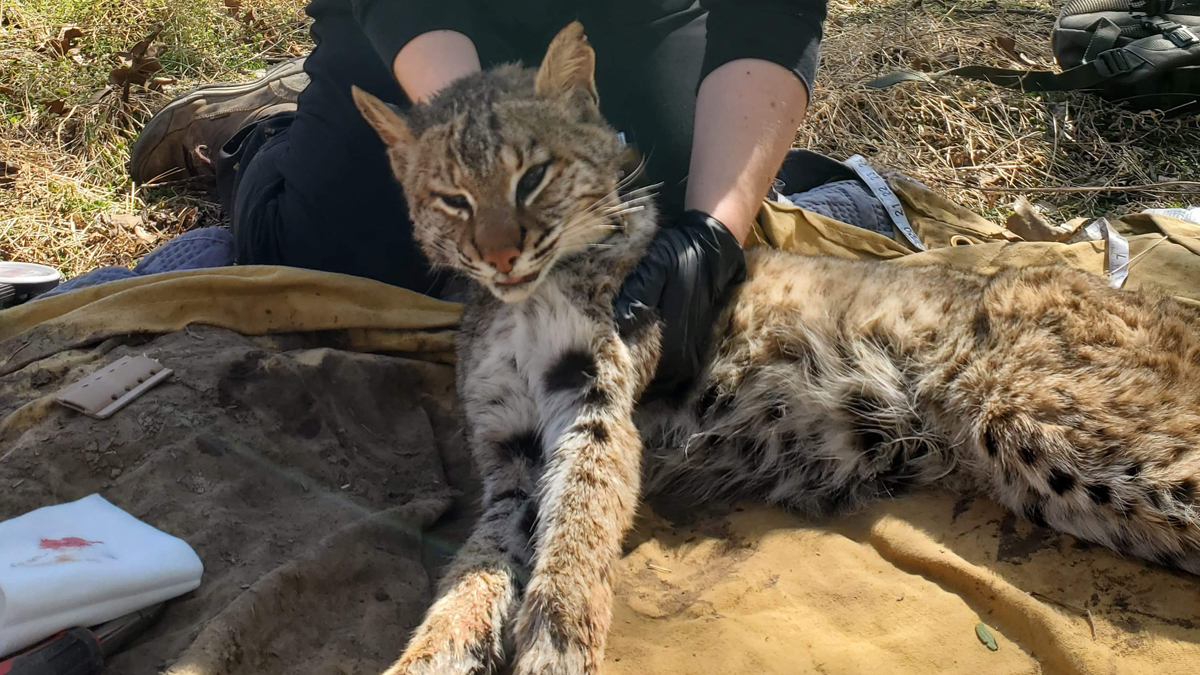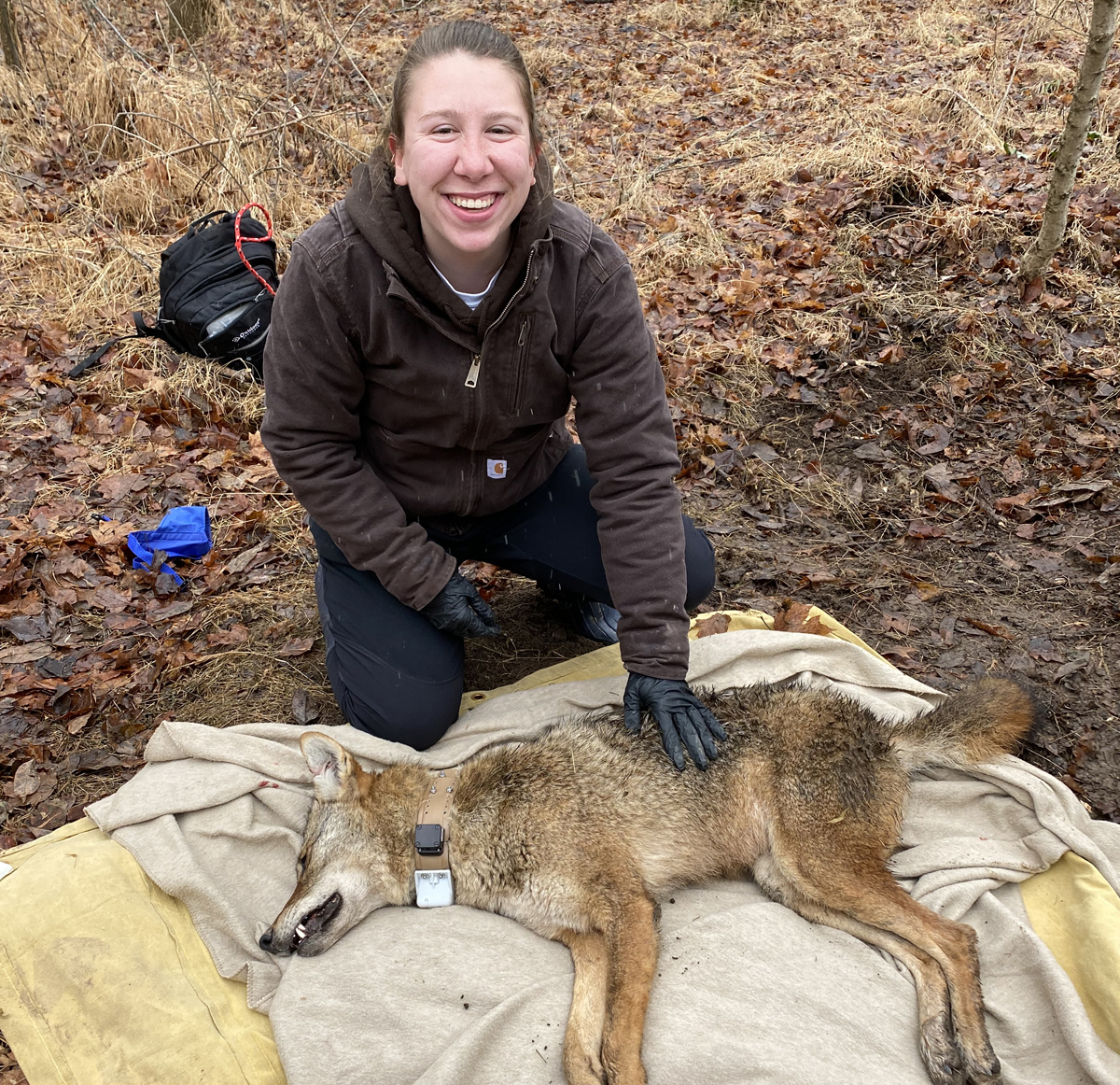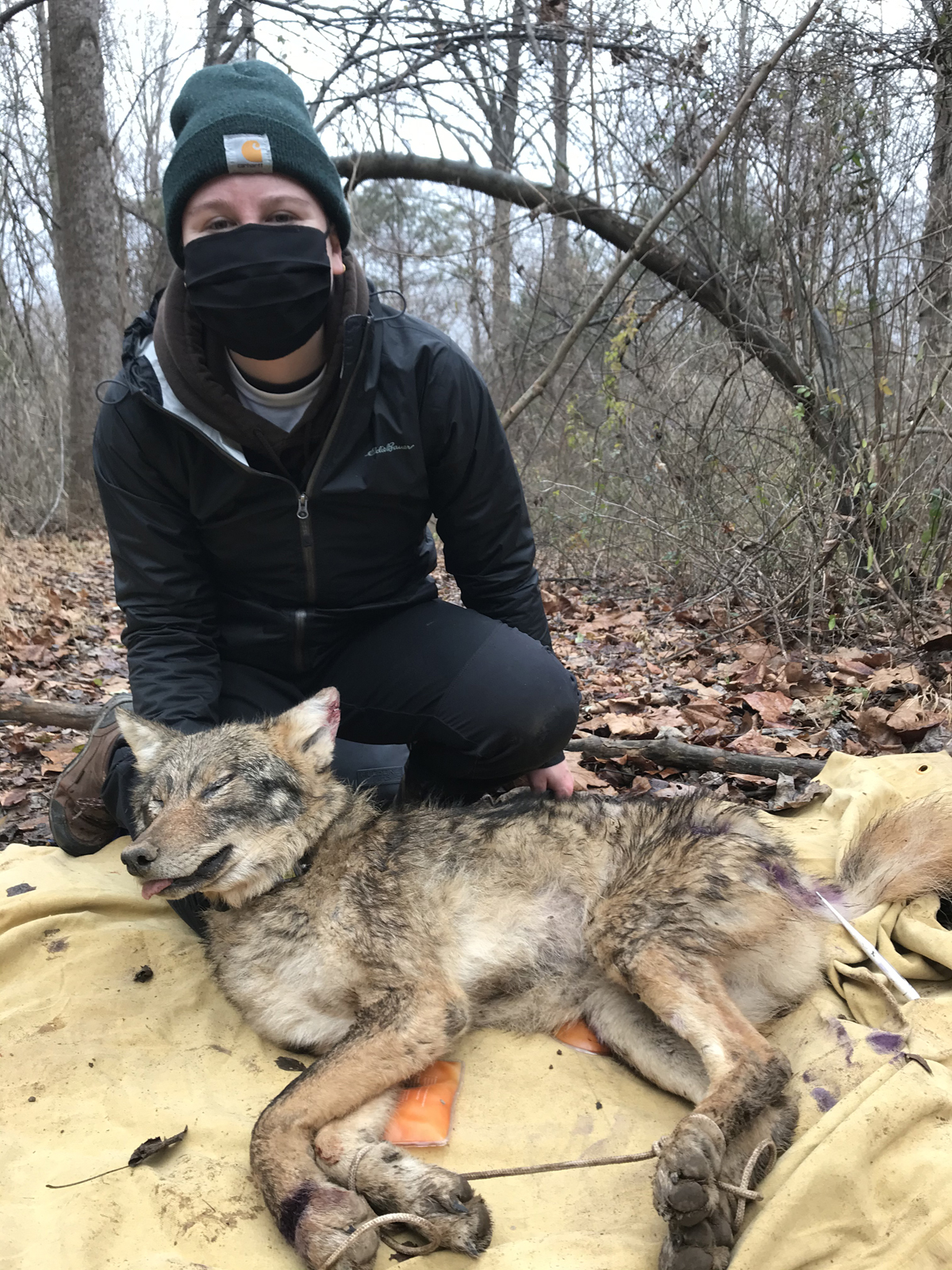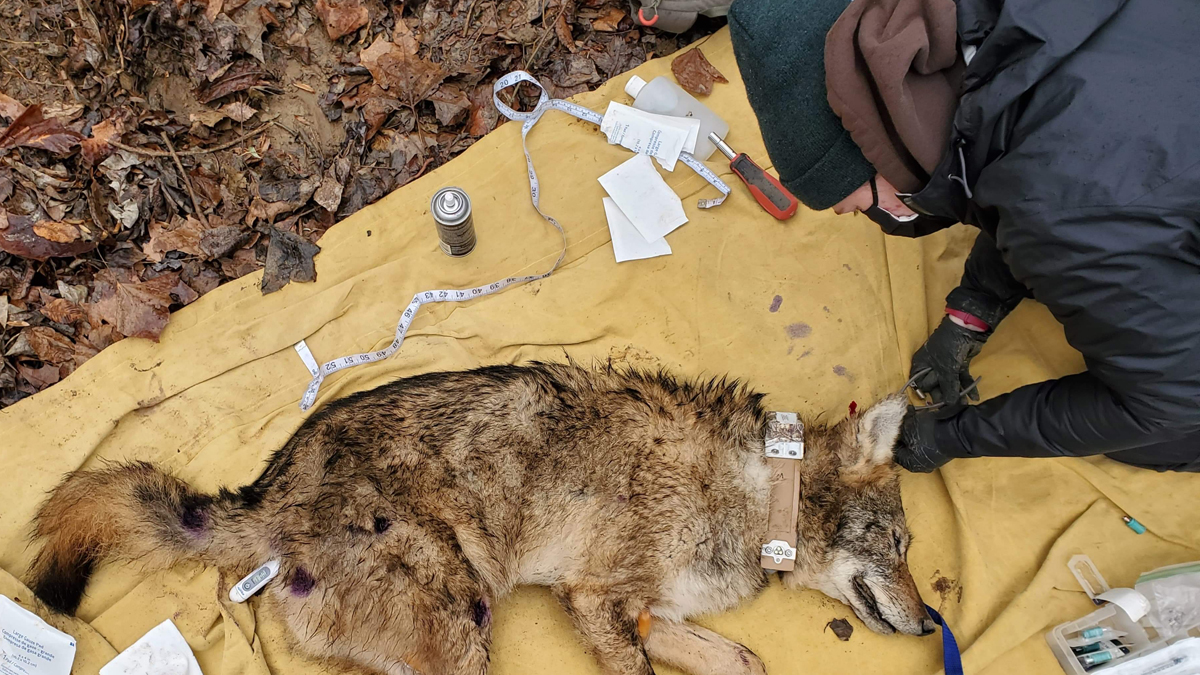
Nicole Gorman, a graduate student in zoology and research assistant at Cooperative Wildlife Research Laboratory at Southern Illinois University Carbondale, fits a captured bobcat with a GPS tracking collar. Gorman is studying bobcat and coyote movement in Southern and Central Illinois and their impact on areas where they live. She is focusing on multispecies systems and the spatial behavior of wildlife in the two different environments – one forested and the other agricultural and more influenced by humans. (Photo provided)
July 08, 2021
SIU student wildlife biologist researches how coyotes’ and bobcats’ travels impact ecosystem
CARBONDALE, Ill. — You’d probably be surprised just how far a coyote or bobcat will go for a steady supply of good food and habitat, says a graduate researcher at Southern Illinois University Carbondale.
The occasional cougar or bear sighted in the Southern Illinois area notwithstanding, coyotes and bobcats are pretty much the apex wildlife predators in Illinois. The four-legged hunters like to sink their fangs into just about anything, be it feathered or furry, while living everywhere from farm fields, to city neighborhoods and college campuses to the deep, dark woods of the state’s national forests and state parks.
Nicole Gorman, a graduate student in zoology and research assistant at SIU’s Cooperative Wildlife Research Laboratory, is studying bobcat and coyote movement in Southern and Central Illinois and their impact on areas they live in. A Granger, Indiana, native, Gorman is focusing on multispecies systems and the spatial behavior of wildlife in the two different environments – one forested and the other agricultural and more influenced by humans.
Keeping an eye on predators
It’s important that scientists study midsized predators such as bobcats and coyotes because they are the top predator species throughout much of North America, Gorman said. Looking closely at their impact on their prey and ecosystems is elemental to understanding how things work together.
“Studying predator movement specifically can provide scientists with more details about their behavior and how they might be interacting with their environments and other species around them,” Gorman said. “This understanding can lead to effective wildlife management, benefiting predator and prey species alike.”
Gorman began the project in November 2019. Since starting the project, she and others have captured and tracked 33 of the predators at two sites, including SIU’s Touch of Nature Environmental Center and Giant City State Park near Makanda and the area around Lake Shelbyville in Central Illinois.
Getting up close and personal
Gorman captures the animals using foot-hold and cage traps, which safely detain them. But catching the wily creatures is an extremely complex process, she said.
“We have to constantly think one step ahead of what the animals may do,” she said.
Once captured, each bobcat and coyote is fitted with a collar that transmits their GPS location, which is recorded every 90 minutes. She then uses the uploaded data to narrow down each individual’s home range and the habitat types available to it, such as forest, agriculture and the wildland-urban interface. Once the collar has been attached to an animal for one year, it automatically drops off for retrieval.
The data may reveal the animal’s habitat preferences, as well as what they tend to avoid. She also is examining interactions with deer and fawns and specifically whether the predators tend to move toward areas where fawns live during the summer.
After examining all the data, she also hopes to determine how individualistic the behaviors of bobcats and coyotes are, and how such differences impact the ways in which they select habitat.
Gorman’s work is part of a larger project studying white-tailed deer movement and their predators around Illinois. The U.S. Wildlife Restoration Fund, in collaboration with the Illinois Department of Natural Resources, is funding the work.
The study, which she hopes to complete in December, keeps her busy.
“When I’m not in the field for captures or in class, I’ve worked on analyzing the data, looking at home range size and location, as well as the resources that the predators are selecting within their home ranges,” Gorman said.
SIU values hands-on research for students
Guillaume Bastille-Rousseau, an assistant professor in the Cooperative Wildlife Research Laboratory, supervises Gorman’s work and her development as a graduate student. He said bobcats were at the edge of extinction just 50 years ago in Illinois, but previous conservation efforts by others helped bring them back.
“Understanding the space-use behavior of these predators will help us further understand their habitat requirements and how they can co-habit with humans,” Bastille-Rousseau said. “Coyotes are found throughout Illinois, including in urban, suburban and rural areas. Nicole’s project specifically tries to understand how both species adapt their behaviors across these different landscapes.”
Surprising preliminary findings
While the data are still coming in, Gorman said she’s been fascinated to find the extent of their movement seems to be related to the type of habitat available to them.
“The individuals here in Southern Illinois have a lot of forested habitat available to them and have smaller home ranges in general,” she said. “In contrast, the individuals we track in Central Illinois live in a much more agricultural area, which causes them to have much larger home ranges and move more around their area. This difference includes home ranges as small as 2 square miles to as large as over 200 square miles.”
Another surprise is how far some of the animals will range.
“Some of them leave the area completely,” she said. “One coyote we’ve named Arwen made a 100-mile journey from Lake Shelbyville to the eastern suburbs of St. Louis, and a bobcat, Mithrandir, made several excursions from Mattoon, Illinois, before heading 120 miles northeast, settling in Indiana.
“It has been fascinating to see the aspects of their environment that influence predator behavior and how individuals react differently to the world around them.”
Getting to know Illinois top predators in such an intimate way has been extremely rewarding, Gorman said.
“Bobcats and coyotes are extremely interesting animals, and their adaptability allows them to live in many different surroundings, including around humans,” she said. “Many people probably have predators around their neighborhoods here in Southern Illinois and never see any sign of them.”
SIU opens the future
Gorman currently is preparing to pursue her doctoral degree and hopes to become a wildlife biologist for the federal government. Making a positive impact on wildlife conversation is her ultimate goal, and SIU is helping her prepare for that journey.
“The guidance from my advisor, as well as the close-knit community of the other graduate students in the Cooperative Wildlife Research Lab, have been extremely helpful in both my journey with this project and preparing me for my future research career,” she said.
Bastille-Rousseau said Gorman is specializing in wildlife ecology and management, and that typical jobs in that field require an eclectic mix of skillsets ranging from hands-on experiences handling wildlife in harsh field settings to advanced computational skills. Her project is unique in that she can be hiking in frigid or pouring weather checking her traps for bobcats or coyotes in the morning and be attending a class or analyzing her data on the computer in the afternoon.

Nicole Gorman, a graduate student in zoology and research assistant at Cooperative Wildlife Research Laboratory at Southern Illinois University Carbondale, fits a captured coyote with a GPS tracking collar. Gorman is studying bobcat and coyote movement in Southern and Central Illinois and their impact on areas where they live. She is focusing on multispecies systems and the spatial behavior of wildlife in the two different environments – one forested and the other agricultural and more influenced by humans. (Photo provided)

Nicole Gorman, a graduate student in zoology and research assistant at Cooperative Wildlife Research Laboratory at Southern Illinois University Carbondale, fits a captured coyote with a GPS tracking collar. Gorman is studying bobcat and coyote movement in Southern and Central Illinois and their impact on areas where they live. She is focusing on multispecies systems and the spatial behavior of wildlife in the two different environments – one forested and the other agricultural and more influenced by humans. (Photo provided)

Nicole Gorman, a graduate student in zoology and research assistant at Cooperative Wildlife Research Laboratory at Southern Illinois University Carbondale, fits a captured coyote with a GPS tracking collar. Gorman is studying bobcat and coyote movement in Southern and Central Illinois and their impact on areas where they live. She is focusing on multispecies systems and the spatial behavior of wildlife in the two different environments – one forested and the other agricultural and more influenced by humans. (Photo provided)
